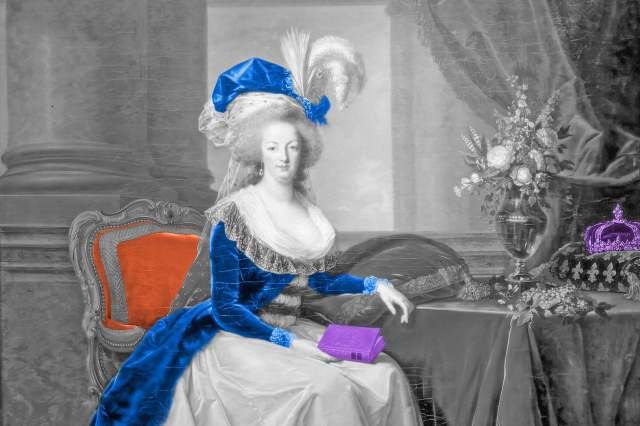
The Future French Queen Had To Cram for Her Wedding
Born in 1755 to Holy Roman Emperor Francis I and Empress Maria Theresa, the archduchess was the 15th of 16 children and enjoyed a carefree childhood due to the lax oversight of her governess. However, her leisurely lifestyle came to an end with the arrangement (at age 13) of her marriage to the Dauphin of France, and with it the discovery that she was barely literate. The French court promptly provided tutor Abbé de Vermond, who sent back reports of his pupil’s short attention span and painfully slow handwriting. Ultimately, the cram sessions helped Marie Antoinette gain a command of French language and history, while the efforts of a Parisian ballet teacher ensured that the up-to-speed archduchess could properly comport herself with the grace of a queen.

Marie Antoinette Was a Fashion Icon
Of all the outrageous accusations attached to Marie Antoinette, the one with the most truth concerns her exorbitant spending on gowns and accessories. She often blew past her annual clothing budget of 120,000 livres — nearly $4 million in 2024 dollars — and reportedly purchased up to 300 new dresses per year. But it was her devotion to appearances, guided by the deft hand of her “Minister of Fashion” Rose Bertin, that made the queen a trendsetter in her time. Along with donning ornate outfits like her diamond-encrusted wedding dress, Marie Antoinette pushed the envelope by carrying a towering pouf hairdo. Even when she stoked outrage by dressing down in a chemise-style muslin gown for an official portrait, this particular mode of dress quickly picked up in popularity across the rest of Europe.

It’s Unlikely She Ever Said “Let Them Eat Cake”
While we don’t know everything the queen uttered in her private chambers, historians are skeptical she delivered the infamous comment that supposedly signified her indifference to the suffering of her subjects. After all, for all the profligate spending of her early reign, she was also known for giving generously to charities and for the compassion she displayed to people injured in her presence. Furthermore, versions of “Let them eat cake” had previously been attributed to other European royals, including the 17th-century French queen consort Marie-Thérèse. One of the first printed references to the snide remark appeared in philosopher Jean-Jacques Rousseau’s Confessions, which was published when Marie Antoinette was still a relatively unknown archduchess of Austria.
More Interesting Reads

Marie Antoinette Was a Talented Musician
While a young Marie Antoinette found it hard to focus on traditional academic subjects, it was a different story when it came to her musical tutelage. Receiving lessons in instruments including the harp, harpsichord, and the glass armonica, she eventually developed the ability to sight-read musical notation at a professional level. As queen, Marie Antoinette enjoyed singing while playing her beloved harp, and was known to accompany performers such as Chevalier de Saint-Georges on the forte-piano. Not content with merely dusting off her talents every now and then, she also revived a royal musical program and heartily supported her favored conductors, ensuring that those in her orbit were also heavily exposed to her musical passions.

She Gave Birth to Her First Child in Front of a Huge Crowd
While it was common at the time for French queens to give birth before an audience of royals, the eight-year wait between the Louis XVI-Marie Antoinette union and the announcement of her first pregnancy had whipped their subjects into a frenzy of expectation. The result was a crush of onlookers descending on the Palace of Versailles when she finally went into labor in December 1778, with several uninvited guests breaking into her room and scaling the furniture to get a better view. All told, a reported 200 visitors witnessed the delivery of princess Marie-Therese, and the overflowing excitement of the crowd combined with the stress of the delivery caused the new mother to pass out.

The Queen Cherished the Privacy of a Neighboring Palace
A Greek-style structure built near the Palace of Versailles for one of Louis XV’s mistresses, the Petit Trianon was gifted to Marie Antoinette following her ascension to the throne. It became a safe haven for the queen to enjoy her private time away from the prying eyes of the royal court, and to that end she had window paneling, lighting, and decorations redone to her tastes. On the grounds, she oversaw the installation of a theater and the “Hameau de la Reine,” a picturesque village with a windmill and a working farm. While it’s oft been repeated that Marie Antoinette and her friends galavanted around the farm dressed as peasants, this seems to be another unfortunate rumor designed to tarnish her reputation.

She Was Scandalized by the “Affair of the Diamond Necklace”
In the mid-1780s, the conniving Countess de La Motte approached the Cardinal de Rohan with a request to buy an expensive diamond necklace on behalf of the queen. Having run afoul of her highness’s good graces, the cardinal eagerly agreed to the task and arranged a payment plan with the jewelers. However, Marie Antoinette was unaware of any of this, and the hoax came to light when the jewelers sought the rest of the money owed by their surprised royal client. The countess was arrested, flogged, and imprisoned, but the “Affair of the Diamond Necklace” also tainted the queen as yet another example of the obscene wealth that passed through her grasp while commoners were starving.

Marie Antoinette Likely Was Involved in an Affair With a Swedish Count
The subject of all sorts of salacious gossip and vulgar depictions, Marie Antoinette supposedly slept with court officers and even family members to satisfy her wild sexual cravings. The allegations were largely false, of course, yet evidence suggests she had an extramarital relationship with Swedish count Axel Fersen. A Swedish ambassador once observed that the queen could barely conceal her feelings for Fersen in public, and the count was known to stay at the Petit Trianon — without the king around — when visiting the country. While Fersen destroyed much of their correspondence and redacted the content of surviving letters, the recent application of X-ray technology on the hidden sections revealed some intimate language between the two.

The Imprisoned Queen Nearly Escaped Execution By Way of the “Carnation Plot”
While imprisoned at the Conciergerie in Paris in August 1793, Marie Antoinette was visited by the royalist Chevalier of Rougeville. Although accounts of the story vary, Rougeville was said to have dropped a carnation concealing a brief note about a plan to squire her to safety. A few days later, he arrived to escort the queen off the premises; however, although the guards had been bribed, one of them reneged on the deal and refused to cooperate. The so-called “Carnation Plot” led to a string of arrests and heightened security, and hastened the arrival of the show trial that condemned the queen to execution a few weeks later.












